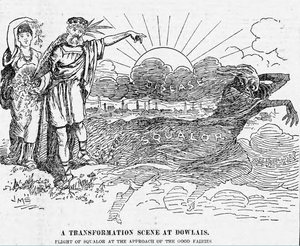Transformation scene
The transformation scene is a theatrical convention of metamorphosis, in which a character, group of characters, stage properties or scenery undergo visible change. Transformation scenes were already standard in the European theatrical tradition with the masques of the 17th century. They may rely on both stage machinery and lighting effects for their dramatic impact.

In the Early Modern masque
The masques of Inigo Jones and Ben Jonson settled into a form that had an antimasque preceding a courtly display, the two parts being linked by a transformation scene.[1] The scene is an abstract representation of the royal power of bringing harmony.[2] Comus, the masque written by the poet John Milton, implies a transformation scene heralded by the arrival of the character Sabrina.[3]
British pantomime
Change by theatrical means has been seen as central to the pantomime of the Victorian period.[4] After a long evolution, a transformation scene then became standard at the end of Act 1 or beginning of Act 2 of a pantomime.[5] The convention in the middle of the 19th century was of a long transformation scene, of up to 15 minutes.[6]
In the later 18th century, genres including the harlequinade and masque ended with a transformation scene to a temple, drawing to a close with the suggestion of harmony restored.[7] John Rich, earlier in the century, made Harlequin with his slap stick able to transform stage props; and later Joseph Grimaldi as Clown was in charge of transformations. Early pantomime related to and contained the traditional harlequinade by means of a transition in which a group of characters descended from the traditional types from the commedia del arte were transformed and "revealed" as being the key characters in the pantomime of the fairy tale that followed.[8] A production in 1781 of Robinson Crusoe by Richard Brinsley Sheridan is credited with breaking down the rigid separation implied by the transformation, leading to the 19th century view of pantomime.[9]
_(1909)_(14739815486).jpg)
The dominance of transformation scenes as spectacular ends in themselves has been attributed to the work of William Roxby Beverly, from 1849. By the 1860s, Beverly's work as a scene painter displaced the costume change bringing in the harlequinade in some productions.[10] The extravaganza became differentiated from the pantomime by, among other things, the centrality of a "magical transformation scene" and the diminishing of the harlequinade clowning.[11] Some British and American Victorian burlesques also retained a transformation scene.[12]
Realms of Bliss
In the later Victorian pantomime, and before the era of the pantomime dame initiated by Dan Leno, a transformation scene revealing Fairyland was the stock ending. As described by Percy Hetherington Fitzgerald, by a slow process a well-lit landscape appears (the "Realms of Bliss"). And in it, fairies are seen, rising from the ground, or hanging in the air.[13] In The Adventures of Philip by William Makepeace Thackeray from the early 1860s, "The Realms of Bliss" is the title of the final chapter, and Thackeray can assume his readers were familiar with the penultimate "dark scene" that precedes it, the entrance of the Good Fairy, and the ultimate wedding of Harlequin and Columbine.[14][15] An 1886 musical version of Alice in Wonderland, classed as an extravaganza, revealed the Realms of Bliss at the start, darkening only at the end when Alice awakes.[16] Peter Pan is embedded in the pantomime tradition, and in its original stage production of 1904, Peter Pan, or The Boy Who Wouldn't Grow Up, ended with a magical transformation scene, returning to Neverland.[17]
Notes
- Skiles Howard (1998). The Politics of Courtly Dancing in Early Modern England. Univ of Massachusetts Press. p. 110. ISBN 1-55849-144-9.
- Pascale Aebischer (30 July 2010). Jacobean Drama. Palgrave Macmillan. pp. 90–. ISBN 978-1-137-06669-5.
- William Shullenberger (2008). Lady in the Labyrinth: Milton's Comus as Initiation. Associated University Presse. p. 300 note 51. ISBN 978-0-8386-4174-3.
- Daphne Brooks (2006). Bodies in Dissent: Spectacular Performances of Race and Freedom, 1850-1910. Duke University Press. p. 23. ISBN 0-8223-3722-3.
- Kirsten Stirling (22 December 2011). Peter Pan's Shadows in the Literary Imagination. Routledge. p. 78. ISBN 978-1-136-49362-1.
- Michael R. Booth (26 July 1991). Theatre in the Victorian Age. Cambridge University Press. p. 199. ISBN 978-0-521-34837-9.
- James Chandler; Kevin Gilmartin (13 October 2005). Romantic Metropolis: The Urban Scene of British Culture, 1780-1840. Cambridge University Press. p. 214. ISBN 978-0-521-83901-3.
- Frederick Burwick (9 March 2015). Romanticism: Keywords. John Wiley & Sons. p. 104. ISBN 978-0-470-65983-0.
- Andrew O'Malley (31 July 2012). Children's Literature, Popular Culture, and Robinson Crusoe. Palgrave Macmillan. p. 103. ISBN 978-1-137-02732-0.
- Jill Alexandra Sullivan (2011). The Politics of the Pantomime: Regional Identity in the Theatre, 1860-1900. Univ of Hertfordshire Press. p. 32. ISBN 978-1-902806-89-1.
- John Shepherd; David Horn (8 March 2012). Continuum Encyclopedia of Popular Music of the World Volume 8: Genres: North America. A&C Black. p. 387. ISBN 978-1-4411-6078-2.
- Robert Clyde Allen (1991). Horrible Prettiness: Burlesque and American Culture. Univ of North Carolina Press. p. 102. ISBN 978-0-8078-4316-1.
- Kara Reilly (23 October 2013). Theatre, Performance and Analogue Technology: Historical Interfaces and Intermedialities. Palgrave Macmillan. pp. 100–1. ISBN 978-1-137-31967-8.
- Carol T. Christ; John O. Jordan (1995). Victorian Literature and the Victorian Visual Imagination. University of California Press. p. 87 note 18. ISBN 978-0-520-20022-7.
- William Makepeace Thackeray (1862). The Adventures of Philip on His Way Through the World. E.R. DuMont. p. 307.
- Tracy C. Davis (20 December 2011). The Broadview Anthology of Nineteenth-Century British Performance. Broadview Press. p. 476. ISBN 978-1-77048-298-2.
- Donna R. White; C. Anita Tarr (1 January 2006). J.M. Barrie's Peter Pan in and Out of Time: A Children's Classic at 100. Rowman & Littlefield. pp. xvi. ISBN 978-0-8108-5428-4.